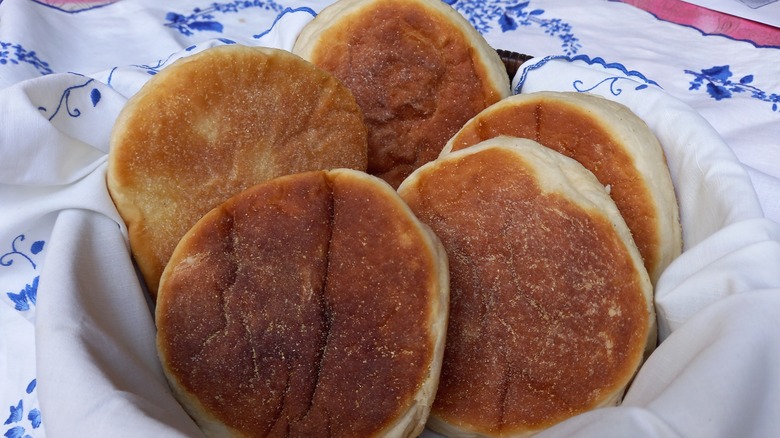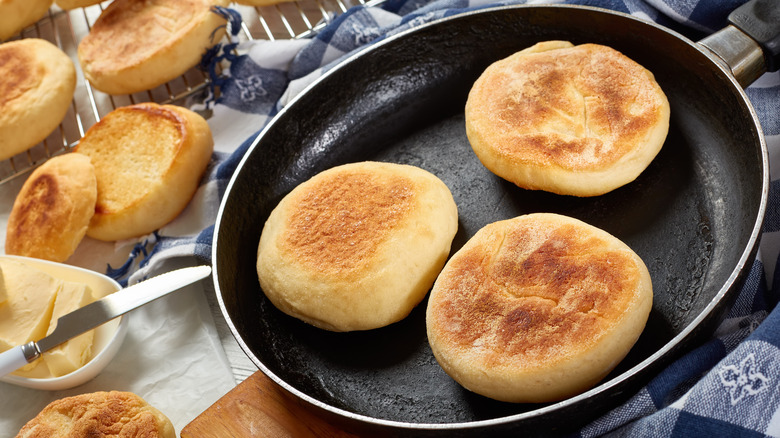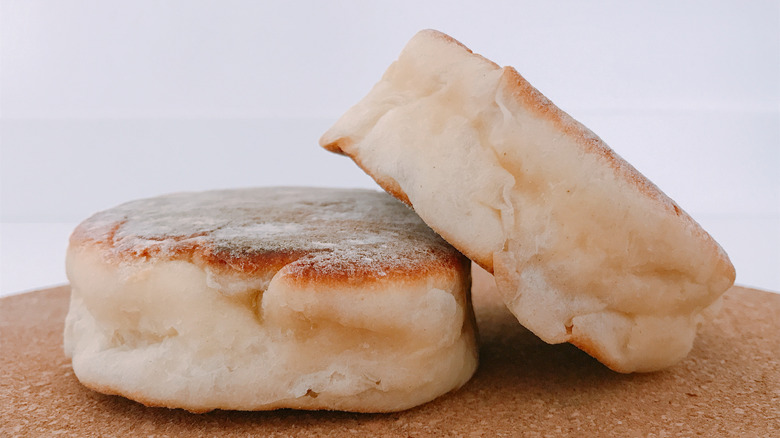Bolos Lêvedos: The Portuguese Lookalike Of English Muffins
Bolos lêvedos are a type of Portuguese bread that, from the outside, looks very similar to English muffins. They're shaped like a circle, measure around an inch tall, and have a toasted top and bottom. However, you can tell them apart because bolos lêvedos are a couple of inches larger in diameter. They don't have that familiar dusting of cornmeal like English muffins do, either. On the inside, this circular bread is even more different. It's fluffy, moist, and slightly sweet. Unlike an English muffin, it has a pleasant chewiness and density.
Bolos lêvedos originated in the Portuguese Azores island. They famously come from Furnas, a small town on the island of São Miguel. Their name roughly translates to yeast cakes, which is very representative of what they are: a leavened bread with a cake-like sweetness and texture. Although they aren't completely widespread in the United States today, they have a presence in Massachusetts, where Portuguese immigrants settled around Cape Cod and opened bakeries to enjoy a familiar favorite.
Bolos lêvedos are prepared on the stove
Although bolos lêvedos are one of many unique bread recipes that you may have never heard of before, they are quite simple to make. Bolos lêvedos are enriched bread containing basic ingredients of butter, eggs, flour, milk, salt, sugar, and yeast. These basic ingredients made bolos lêvedos a very accessible and staple food of the Azores when obtaining ingredients on the islands was difficult. The preparation method requires some patience, involving kneading and proofing like any other leavened bread. To achieve its characteristic shape, the dough is formed into circular disks before it is cooked.
Similar to English muffins, bolos lêvedos are traditionally cooked on the stovetop. This is how both muffins get their toasted top and bottom. When they are carefully cooked on medium-low heat, they will develop a beautiful golden-brown circle on either side while the dough in the middle gets a chance to cook through. Tearing a perfect bolo lêvedo open should reveal a soft and fluffy bread with a density reminiscent of cake.
Bolos lêvedos vs. English muffins
Perhaps the closest relative to bolos lêvedos is the English muffin. They may be cooked the same, and look the same, but their differences come down to ingredient alterations. Unlike English muffins that have a very airy crumb with nooks and crannies, bolos lêvedos' lack big air pockets and have a chewier texture due to their higher egg and butter content.
You may also recall the slightly tangy flavor that is unique to an English muffin. Bolos lêvedos, on the other hand, have a mild and sweet flavor due to their higher sugar content. Whereas a standard English muffin recipe will call for a couple of tablespoons of sugar at most, bolos lêvedos have enough sugar to make them noticeably sweet. This subtle sweetness is one of the defining qualities of a bolo lêvedo that merits its 'yeast cake' name.
How to eat bolos lêvedos
The best things about bolos lêvedos are their pleasant texture and flavor which make them good for enjoying anytime. Bolos lêvedos are satisfying enough to eat completely on their own. Like many other breads, they're best when they're fresh and warm. To elevate them, you can enhance the flavor of bolos lêvedos with a bit of butter and jam. People often cut them in half like a bagel, toast them, and top them with their favorite condiments. Paired with a cup of coffee, bolos lêvedos are representative of a typical breakfast in Portugal.
Bolos lêvedos also make for interesting sandwich bread, too. Their larger size means they can support a more substantial sandwich. The fluffy texture and slight sweetness balance salty and savory meats and cheeses. For instance, they can be used to house a breakfast sandwich with a fried egg, ham, and cheese or a lunchtime meal with some turkey and Swiss inside. Alternatively, when used as a burger bun, bolo lêvedos have a similar effect to brioche that complements the richness of beef.



